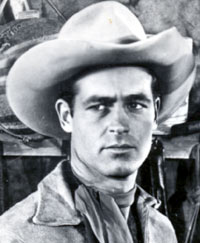 GUY MADISON GUY MADISON
Ratings: Zero to 4 Stars.
 MASSACRE RIVER (‘49 Allied Artists) Highly underrated and overlooked Cavalry western, truly Shakespearian tragedy in nature…lust, broken friendships, secret trysts, unrequited love, unexpected death, hatred, revenge…it’s all here. Three Calvary officers (Guy Madison, Rory Calhoun, Johnny Sands) are assigned to Indian Territory after the Civil War. Both Madison and Calhoun are in love with Sands’ sister, Cathy Downs, who eventually agrees to marry Madison. Then Madison falls for shady lady in town Carole Mathews, leaving Downs brokenhearted. When Mathews’ saloon partner (Steve Brodie) tries to force her to sell out to him, Madison kills him during an argument, resigns from the Army and plans to leave with Mathews. Distraught over his sister’s plight, and believing Madison is making a big mistake, Sands tries to change Madison’s mind but, in a scuffle over Mathews, he too is shot and killed. Angered, Calhoun vows to track down and kill Madison, who has now fled into treacherous Indian Territory with Mathews. The final tragic showdown comes in the desert when the three are trapped by marauding Apaches. A real departure from the norm. Well directed by John Rawlins. MASSACRE RIVER (‘49 Allied Artists) Highly underrated and overlooked Cavalry western, truly Shakespearian tragedy in nature…lust, broken friendships, secret trysts, unrequited love, unexpected death, hatred, revenge…it’s all here. Three Calvary officers (Guy Madison, Rory Calhoun, Johnny Sands) are assigned to Indian Territory after the Civil War. Both Madison and Calhoun are in love with Sands’ sister, Cathy Downs, who eventually agrees to marry Madison. Then Madison falls for shady lady in town Carole Mathews, leaving Downs brokenhearted. When Mathews’ saloon partner (Steve Brodie) tries to force her to sell out to him, Madison kills him during an argument, resigns from the Army and plans to leave with Mathews. Distraught over his sister’s plight, and believing Madison is making a big mistake, Sands tries to change Madison’s mind but, in a scuffle over Mathews, he too is shot and killed. Angered, Calhoun vows to track down and kill Madison, who has now fled into treacherous Indian Territory with Mathews. The final tragic showdown comes in the desert when the three are trapped by marauding Apaches. A real departure from the norm. Well directed by John Rawlins.
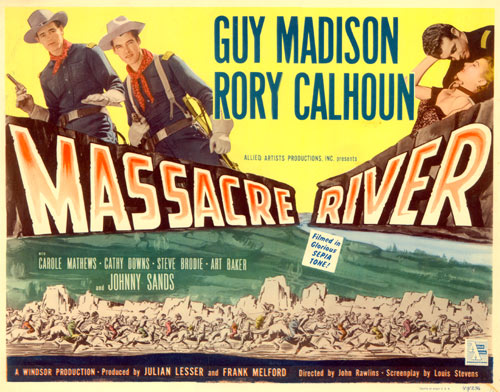
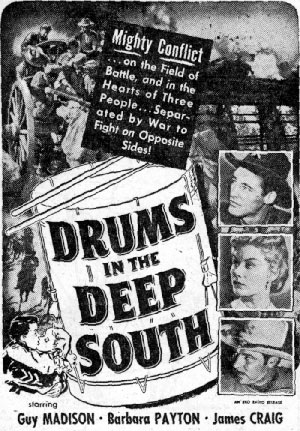  DRUMS IN THE DEEP SOUTH (‘51 King Bros./RKO) Striving for another epic Civil War drama, Oscar winning art director/production manager turned director William Cameron Menzies adds a few nice touches to the plot, but ultimately this is just an expanded B-film. Two West Point graduates find themselves on opposite sides at the outbreak of the Civil War. James Craig is a Confederate Major while Guy Madison is a Yankee officer. Three years into the war they oppose each other when General Sherman makes his advance toward Atlanta through bloodied Georgia. The advance of Major Madison’s Union troops are blocked by Craig and 20 Rebel soldiers who have mounted three cannon on top of Devil’s Mountain where they can pound away at Sherman’s supply trains down below, bombarding the only route through the plantation country. Craig’s old sweetheart, Barbara Payton, whose manor has been seized by Union forces, manages to spy on Madison and deliver information to Craig. Filmed in SuperCineColor. DRUMS IN THE DEEP SOUTH (‘51 King Bros./RKO) Striving for another epic Civil War drama, Oscar winning art director/production manager turned director William Cameron Menzies adds a few nice touches to the plot, but ultimately this is just an expanded B-film. Two West Point graduates find themselves on opposite sides at the outbreak of the Civil War. James Craig is a Confederate Major while Guy Madison is a Yankee officer. Three years into the war they oppose each other when General Sherman makes his advance toward Atlanta through bloodied Georgia. The advance of Major Madison’s Union troops are blocked by Craig and 20 Rebel soldiers who have mounted three cannon on top of Devil’s Mountain where they can pound away at Sherman’s supply trains down below, bombarding the only route through the plantation country. Craig’s old sweetheart, Barbara Payton, whose manor has been seized by Union forces, manages to spy on Madison and deliver information to Craig. Filmed in SuperCineColor.
Sixteen Wild Bill Hickok “features” were released by Monogram between Fall ‘52 and Spring ‘55. Each “feature” was comprised of two “Wild Bill Hickok” TV episodes edited together. The Hickok 30 min. TV series, with Guy Madison as Wild Bill and Andy Devine as his deputy Jingles P. Jones, began airing in April 1951 and continued for 113 episodes through 1958. The edited “features” were shown at theatres as distinct B-westerns with no advertising to imply they were culled from the TV series. For identification here are the theatrical titles along with the TV episodes from which they were compiled.
BEHIND SOUTHERN LINES (‘52 Monogram) “Behind Southern Lines” (TV episode 1)/“Silver Mine Protection Story” (TV episode 5) with Rand Brooks, Milburn Stone.
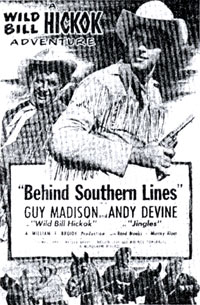
TRAIL OF THE ARROW (‘52 Monogram) “Indian Bureau Story” (TV episode 6)/“Indian Pony Express” (TV episode 7) with Raymond Hatton, Dave Sharpe.
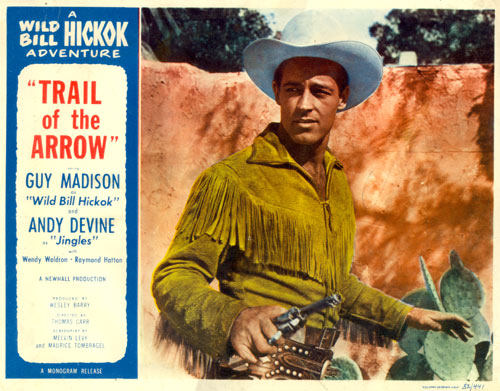
 GHOST OF CROSSBONE CANYON (‘52 Monogram) “Widow Muldane” (TV episode 9)/“Ghost Town Story” (TV episode 10) with Christine Larson, John Ducette. GHOST OF CROSSBONE CANYON (‘52 Monogram) “Widow Muldane” (TV episode 9)/“Ghost Town Story” (TV episode 10) with Christine Larson, John Ducette.
 YELLOW HAIRED KID (‘52 Monogram) “Yellow Haired Kid” (TV episode 11/“Johnny Deuce” (TV episode 12) with David Bruce, Alan Hale Jr. YELLOW HAIRED KID (‘52 Monogram) “Yellow Haired Kid” (TV episode 11/“Johnny Deuce” (TV episode 12) with David Bruce, Alan Hale Jr.
SIX GUN DECISION (‘53 Monogram) “Boulder City Election” (TV episode 14)/“Pony Express vs. Telegraph” (TV episode 15) with Lyle Talbot, Peggy Stewart.
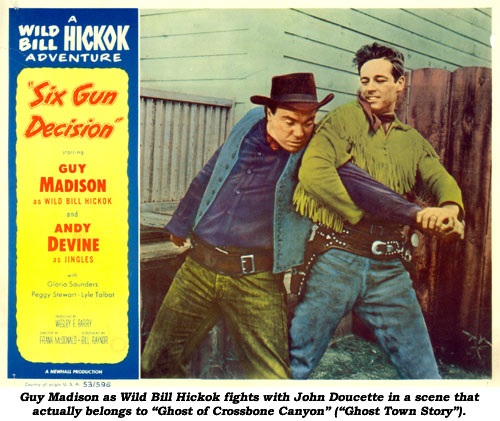
SECRET OF OUTLAW FLATS (‘53 Monogram) “Outlaw Flats” (TV episode 17)/“Silver Stage Holdup” (TV episode 18) with Kristine Miller, Jane Adams.
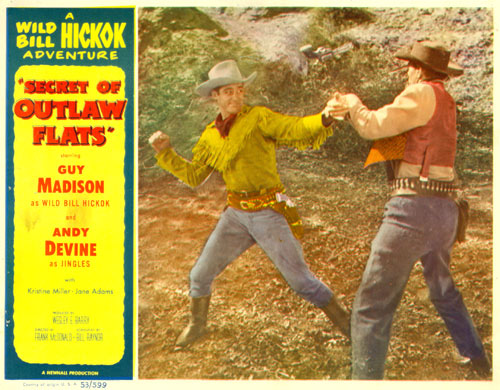
 BORDER CITY RUSTLERS (‘53 Monogram) “Border City” (TV episode 22)/“Ex Convict Story” (TV episode 23) with Gloria Talbot, Bruce Edwards BORDER CITY RUSTLERS (‘53 Monogram) “Border City” (TV episode 22)/“Ex Convict Story” (TV episode 23) with Gloria Talbot, Bruce Edwards
TWO GUN MARSHAL (‘53 Monogram) “Papa Antelli” (TV episode 24)/“Slocum Family” (TV episode 25) with Pamela Duncan, Carole Mathews, Raymond Hatton.
MARSHALS IN DISGUISE (;54 Monogram) “Lost Indian Mine” (TV episode 26)/“Civilian Clothes Story” (TV episode 27) with Dave Sharpe, John Merton.
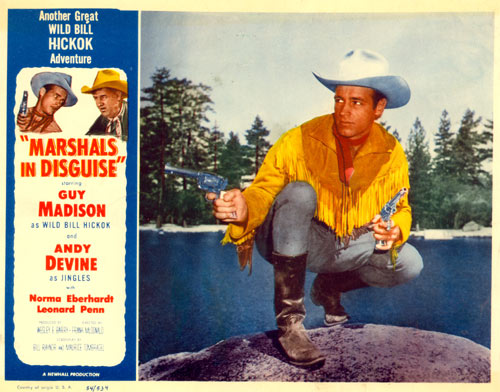
TROUBLE ON THE TRAIL (‘54 Monogram) “Medicine Show” (TV episode 28)/“Blacksmith Story” (TV episode 29) with Carole Mathews, Bob Livingston.
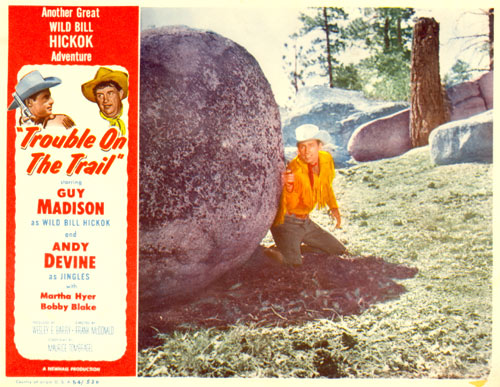
TWO GUN TEACHER (‘54 Monogram) “Mexican Gun Running Story” (TV episode 30)/“School Teacher Story” (TV episode 31) with Tom Tyler, Rand Brooks, Anne Carroll.
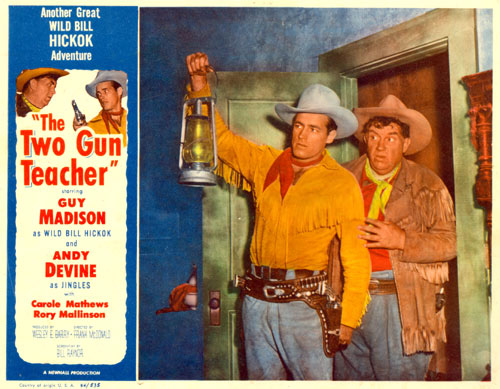
OUTLAW’S SON (‘54 Monogram) “Outlaw’s Son” (TV episode 35)/“Savvy, the Smart Little Dog” (TV episode 36) with Anne Kimble, Jeanne Dean.
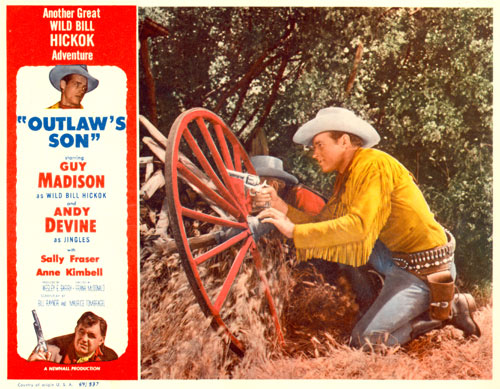
TIMBER COUNTRY TROUBLE (‘55 Monogram) “Wild White Horse” (TV episode 38)/“Lumber Camp Story” (TV episode 39) with Sally Fraser, Kenne Duncan.
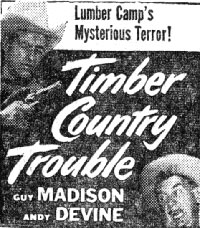
THE TITLED TENDERFOOT (‘55 Monogram) “Trapper’s Story” (TV episode 40)/“A Joke on Sir Anthony” (TV episode 42) with Clayton Moore.
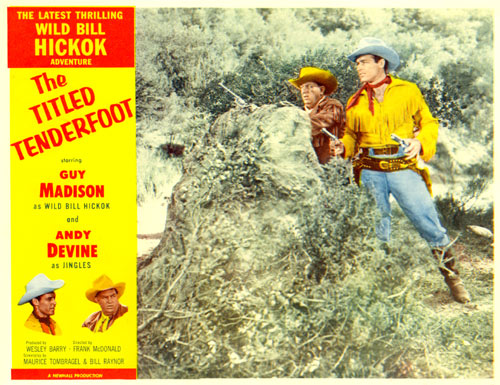
MATCH-MAKING MARSHAL (‘55 Monogram) “Marriage Feud of Ponca City” (TV episode 48)/“Wrestling Story” (TV episode 43) with Forrest Taylor, Lyle Talbot.
PHANTOM TRAILS (‘55 Monogram) “A Close Shave for the Marshal” (TV episode 46)/“Ghost Rider” (TV episode 37) with Steve Brodie.
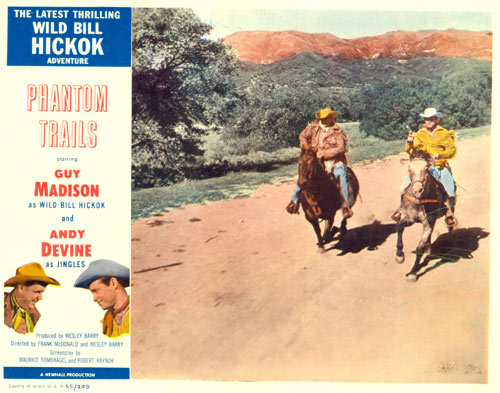
Meantime, Madison continued to star in theatrical westerns.
 CHARGE AT FEATHER RIVER (‘53 Warner Bros.) Guy Madison leads a band of misfits—a reluctant but heroic guardhouse brigade—on a mission to rescue young Ron Hagerthy’s two sisters (Helen Westcott, Vera Miles) from their Indian captors—only to find Miles reluctant to return to a white man’s world. With a better screenplay than most, this is one of the best Indians Vs. Cavalry crop of ‘50s westerns with some intense battle scenes. Only Dick Wesson’s misplaced “comedy” mars the seriousness. You could call Madison’s guardhouse brigade a forerunner to the “dirty dozen”. There’s the tough sergeant (Frank Lovejoy), the womanizer (Steve Brodie), the comic thief (Wesson), the Yank and the Rebel still fighting the Civil War (Lane Chandler, Neville Brand), the alcoholic (Henry Kulky), the journalist (Onslow Stevens) as well as “Rin Tin Tin” cavalry vets James Brown and Rand Brooks. Watch for Carl Andre as Hudkins—he was one of the top horse wranglers in the film business. Remade as an episode of TV’s “Cheyenne: West of the River”. Filmed in 3-D color. CHARGE AT FEATHER RIVER (‘53 Warner Bros.) Guy Madison leads a band of misfits—a reluctant but heroic guardhouse brigade—on a mission to rescue young Ron Hagerthy’s two sisters (Helen Westcott, Vera Miles) from their Indian captors—only to find Miles reluctant to return to a white man’s world. With a better screenplay than most, this is one of the best Indians Vs. Cavalry crop of ‘50s westerns with some intense battle scenes. Only Dick Wesson’s misplaced “comedy” mars the seriousness. You could call Madison’s guardhouse brigade a forerunner to the “dirty dozen”. There’s the tough sergeant (Frank Lovejoy), the womanizer (Steve Brodie), the comic thief (Wesson), the Yank and the Rebel still fighting the Civil War (Lane Chandler, Neville Brand), the alcoholic (Henry Kulky), the journalist (Onslow Stevens) as well as “Rin Tin Tin” cavalry vets James Brown and Rand Brooks. Watch for Carl Andre as Hudkins—he was one of the top horse wranglers in the film business. Remade as an episode of TV’s “Cheyenne: West of the River”. Filmed in 3-D color.
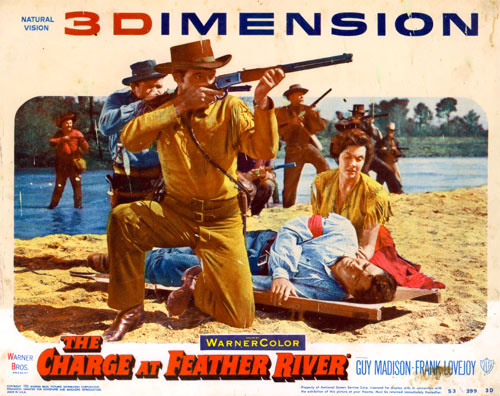
 COMMAND, THE (‘54 Warner Bros.) After scoring a success with the first 3-D western, “Charge at Feather River”, Warner Bros. cast Madison again in the first CinemaScope western, “The Command”. Given a big production under director David Butler (who helmed Errol Flynn’s “San Antonio”), “The Command” sports hundreds of extras in the big battle scenes, of which the final 11 minute sequence spreads across the wide screen virtually making participants of the audience. Unfortunately, it loses much of its sweep when shown on TV. Story concerns cavalry medical officer Madison forced to assume command of a troop when Capt. Gregg Barton is killed by Indians. Pressed into escorting a wagon train through hostile Indian territory, Madison learns the ways of war from tough sergeant James Whitmore in a terrific part (“With the Captain’s permission…”). Perhaps the finest cavalry picture made about the weight of command. COMMAND, THE (‘54 Warner Bros.) After scoring a success with the first 3-D western, “Charge at Feather River”, Warner Bros. cast Madison again in the first CinemaScope western, “The Command”. Given a big production under director David Butler (who helmed Errol Flynn’s “San Antonio”), “The Command” sports hundreds of extras in the big battle scenes, of which the final 11 minute sequence spreads across the wide screen virtually making participants of the audience. Unfortunately, it loses much of its sweep when shown on TV. Story concerns cavalry medical officer Madison forced to assume command of a troop when Capt. Gregg Barton is killed by Indians. Pressed into escorting a wagon train through hostile Indian territory, Madison learns the ways of war from tough sergeant James Whitmore in a terrific part (“With the Captain’s permission…”). Perhaps the finest cavalry picture made about the weight of command.
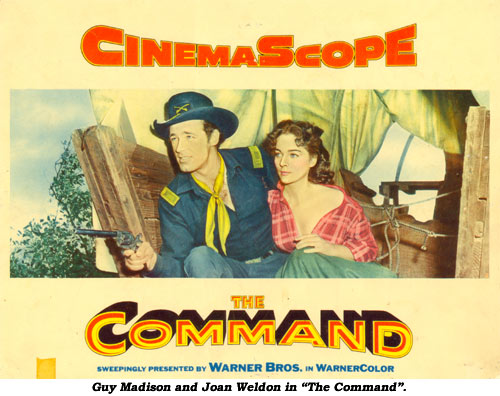
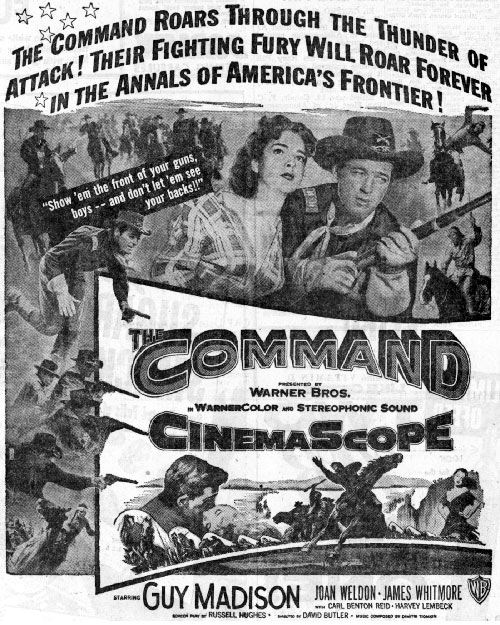
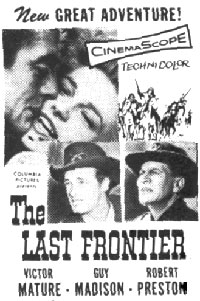  LAST FRONTIER, THE (‘55 Columbia) This Cavalry/Indians big budget loser simply proves director Anthony Mann, who helmed some of the best westerns of the ‘50s, was no better than the material he had to work with; in this case a trashy script from Phillip Yordan and Russell Hughes that has Cavalry Colonel Robert Preston dominating a frontier outpost and formenting war with the Indians while driving his wife (Anne Bancroft) into the arms of trapper/scout Victor Mature. Guy Madison is mostly wasted as a Cavalry Captain, second in command to Preston. LAST FRONTIER, THE (‘55 Columbia) This Cavalry/Indians big budget loser simply proves director Anthony Mann, who helmed some of the best westerns of the ‘50s, was no better than the material he had to work with; in this case a trashy script from Phillip Yordan and Russell Hughes that has Cavalry Colonel Robert Preston dominating a frontier outpost and formenting war with the Indians while driving his wife (Anne Bancroft) into the arms of trapper/scout Victor Mature. Guy Madison is mostly wasted as a Cavalry Captain, second in command to Preston.
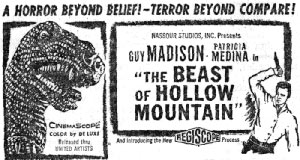
 BEAST OF HOLLOW MOUNTAIN (‘56 U.A.) Dreary 83 minute made-in-Mexico western-Sci Fi cross-genre affair that takes too long to get to the “beast”. Rancher Guy Madison and his partner Carlos Rivas plow through 61 minutes of unnecessary dialogue, a romantic subplot (with Patricia Medina), and a young boy before we got to the Tyrannosaur who is terrorizing the small village. However, the last 22 minutes are pretty exciting with some decent stop-motion animation. BEAST OF HOLLOW MOUNTAIN (‘56 U.A.) Dreary 83 minute made-in-Mexico western-Sci Fi cross-genre affair that takes too long to get to the “beast”. Rancher Guy Madison and his partner Carlos Rivas plow through 61 minutes of unnecessary dialogue, a romantic subplot (with Patricia Medina), and a young boy before we got to the Tyrannosaur who is terrorizing the small village. However, the last 22 minutes are pretty exciting with some decent stop-motion animation.
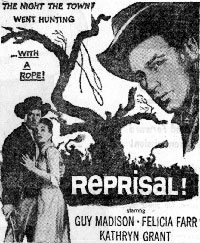  REPRISAL (‘56 Columbia) Torn between his red blood and his white blood, Madison tries to pass for white and own land in a bigoted cowtown. He finally finds his way “as a man”—neither red nor white—in this often overlooked, fine Technicolor A that makes a strong indictment against racial prejudice. Directed by former B-helmer, George Sherman. One of the contributing screenwriters is David Dortort, later creator of TV’s “Bonanza” and “High Chaparral”. The story is based on a novel set in the American South of the ‘50s, with Indians substituted for Negroes and the time period altered. Good Old Tucson and Arizona photography from Henry Freulich which, unfortunately, contains some 3-D effects which only look silly in 2-D on TV. Most of the stunts were done by Republic alumni Eddie Parker and Ken Terrell. Madison’s younger brother, Wayne Mallory, is one of the heavies. REPRISAL (‘56 Columbia) Torn between his red blood and his white blood, Madison tries to pass for white and own land in a bigoted cowtown. He finally finds his way “as a man”—neither red nor white—in this often overlooked, fine Technicolor A that makes a strong indictment against racial prejudice. Directed by former B-helmer, George Sherman. One of the contributing screenwriters is David Dortort, later creator of TV’s “Bonanza” and “High Chaparral”. The story is based on a novel set in the American South of the ‘50s, with Indians substituted for Negroes and the time period altered. Good Old Tucson and Arizona photography from Henry Freulich which, unfortunately, contains some 3-D effects which only look silly in 2-D on TV. Most of the stunts were done by Republic alumni Eddie Parker and Ken Terrell. Madison’s younger brother, Wayne Mallory, is one of the heavies.
 HARD MAN (‘57 Columbia) Tense, taut script catches the middle ground between old fashioned B’s and the adult westerns of the ‘50s with a few elements of film noir thrown in. Although it’s not Madison’s best known western, it may be his best work in a western with a terrific showdown scene in the hotel between Madison and Rudy Bond. Story has too-quick-on-the-trigger lawman Madison opposing tyrannical town boss Lorne Greene (later star of TV’s BONANZA) and his double-crossing, greedy wife Valerie French following the framing and death of Madison’s friend Myron Healey. Produced by Wallace MacDonald and well directed by George Sherman. Important unbilled cameo by B-western vet John Cason. HARD MAN (‘57 Columbia) Tense, taut script catches the middle ground between old fashioned B’s and the adult westerns of the ‘50s with a few elements of film noir thrown in. Although it’s not Madison’s best known western, it may be his best work in a western with a terrific showdown scene in the hotel between Madison and Rudy Bond. Story has too-quick-on-the-trigger lawman Madison opposing tyrannical town boss Lorne Greene (later star of TV’s BONANZA) and his double-crossing, greedy wife Valerie French following the framing and death of Madison’s friend Myron Healey. Produced by Wallace MacDonald and well directed by George Sherman. Important unbilled cameo by B-western vet John Cason.
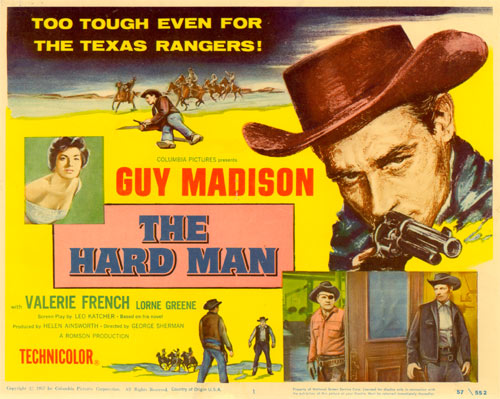
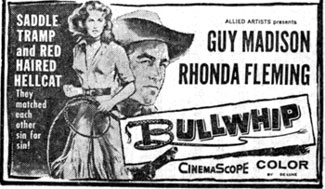 ZERO BULLWHIP (‘58 Allied Artists) Action title suggests something entirely different than the “taming of the shrew” romantic-comedy western that this Guy Madison-Rhonda Fleming starrer actually is. Guy is a cowboy about to hang on a trumped up murder charge. At the last moment, he’s offered a reprieve under the condition he marry Fleming, then disappear. The fiery redhead needs to be married in order to claim her late father’s vast ranchlands, but the hot-tempered, ambitious bride has no place for a man in her life. She enforces her position with a bullwhip but curiosity gets the better of Madison who doesn’t give up easily. Despite a mutual distrust, Madison helps her face some common obstacles and eventually melts Fleming’s icy veneer. As usual in ‘50s westerns, there’s a title tune, and as usual it’s pretty bad (sung by Frankie Laine). Fleming is fine and gorgeous as usual but Madison just has no flair for light comedy. Cinemascope and Color. ZERO BULLWHIP (‘58 Allied Artists) Action title suggests something entirely different than the “taming of the shrew” romantic-comedy western that this Guy Madison-Rhonda Fleming starrer actually is. Guy is a cowboy about to hang on a trumped up murder charge. At the last moment, he’s offered a reprieve under the condition he marry Fleming, then disappear. The fiery redhead needs to be married in order to claim her late father’s vast ranchlands, but the hot-tempered, ambitious bride has no place for a man in her life. She enforces her position with a bullwhip but curiosity gets the better of Madison who doesn’t give up easily. Despite a mutual distrust, Madison helps her face some common obstacles and eventually melts Fleming’s icy veneer. As usual in ‘50s westerns, there’s a title tune, and as usual it’s pretty bad (sung by Frankie Laine). Fleming is fine and gorgeous as usual but Madison just has no flair for light comedy. Cinemascope and Color.
After Guy Madison’s TV and screen career dried up in the U.S. in the late ‘50s, he moved to Europe in ‘61 where he starred for another decade in some two dozen pictures, many of them westerns, but several sword and sandal and adventure films as well.
 OLD SHATTERHAND (aka APACHE’S LAST BATTLE) (‘64) was the third in the German produced Winnetou films starring Lex Barker. Madison is a glory-grabbing Cavalry officer trying to stir up trouble between the Apaches and Comanches. OLD SHATTERHAND (aka APACHE’S LAST BATTLE) (‘64) was the third in the German produced Winnetou films starring Lex Barker. Madison is a glory-grabbing Cavalry officer trying to stir up trouble between the Apaches and Comanches.
 GUNMEN OF THE RIO GRANDE (aka DUEL AT RIO BRAVO) (‘64) stars Guy Madison as a very fictional Wyatt Earp in Mexico trying to bring law and order to a mining town. The French/Italian/Spanish co-production features some good desert locations and the action is okay when it comes. GUNMEN OF THE RIO GRANDE (aka DUEL AT RIO BRAVO) (‘64) stars Guy Madison as a very fictional Wyatt Earp in Mexico trying to bring law and order to a mining town. The French/Italian/Spanish co-production features some good desert locations and the action is okay when it comes.
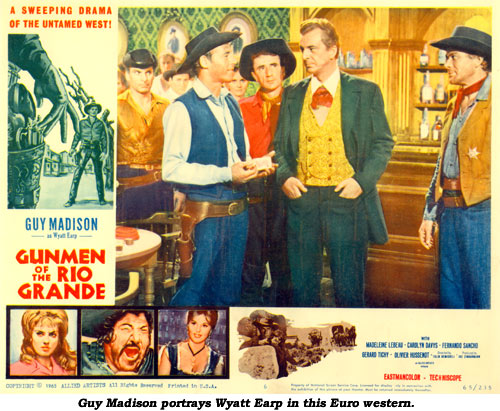
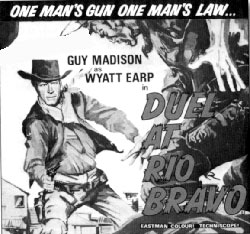
ZERO FIVE GIANTS FROM TEXAS (aka FIVE FOR REVENGE) (‘66) is a fairly standard revenge tale with Guy Madison leading four men and a woman (their murdered friend’s wife) across Mexico searching for the killers. Pretty threadbare Italian/Spanish co-production.
LEGACY OF THE INCAS (‘60) Not available for viewing.
ZERO PAYMENT IN BLOOD (aka RENEGADE RIDERS; WINCHESTER FOR HIRE) (‘67) Italian production released in the U.S. by Columbia. Guy Madison is a Confederate Colonel who won’t let the Civil War end, continuing to raid and pillage, all the while searching for a General’s lost treasure. FBI agent Edd Byrnes is assigned to stop Madison. Not particularly well filmed and Byrnes seems self-absorbed in looking pretty for the camera, not wearing a hat so as not to muss his “Kookie” hair.
ZERO SON OF DJANGO (aka VENGEANCE IS A COLT) (‘67) Gabriele Tinti is the now-grown son of famous gunman Django seeking revenge for the murder of his father. Guy Madison doesn’t enter til the 35 minute mark and then he’s a preacher-character, at least until he straps on a six-gun to help Tinti.
ZERO BANG BANG KID (‘67) Spanish/Italian serio-comic western with Guy Madison as a power-hungry town boss who lives in a castle (?!?) Tom Bosley (!) co-stars.
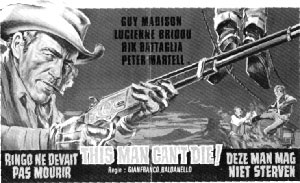  THIS MAN CAN’T DIE (aka LONG DAYS OF HATE) (‘68) Government agent Guy Madison after Rik Batlaglia’s gun runners, who also happen to be the gang who slaughtered most of his family and raped his sister. Far better production values, photo-graphy, scenery and direction than many Euro-oater quickies, giving it a better look and feel. Plenty of well-staged action. This one’s worth your while. THIS MAN CAN’T DIE (aka LONG DAYS OF HATE) (‘68) Government agent Guy Madison after Rik Batlaglia’s gun runners, who also happen to be the gang who slaughtered most of his family and raped his sister. Far better production values, photo-graphy, scenery and direction than many Euro-oater quickies, giving it a better look and feel. Plenty of well-staged action. This one’s worth your while.
ZERO REVEREND COLT (‘70) Badly dubbed Italian/Spanish co-production with bounty hunter turned priest Guy Madison forced to track down bank robbers in order to build a church. Too much yak and not enough spaghetti-action for its 84 minute running time.
top of page |

